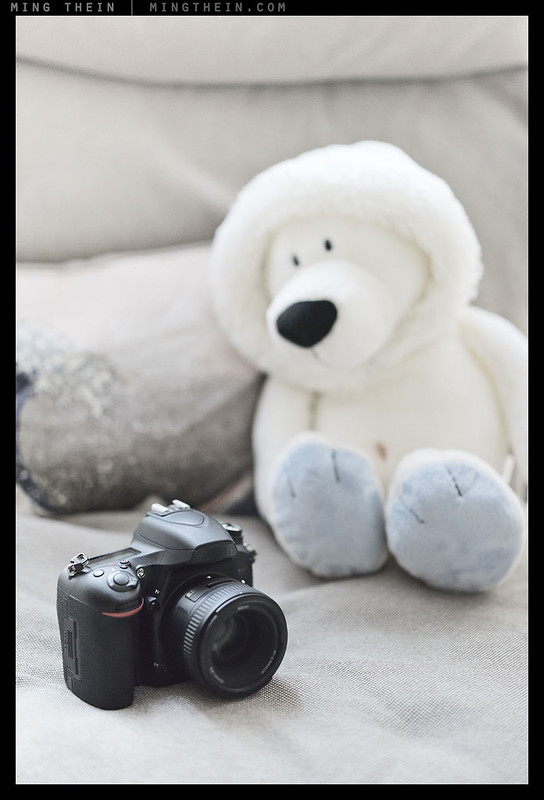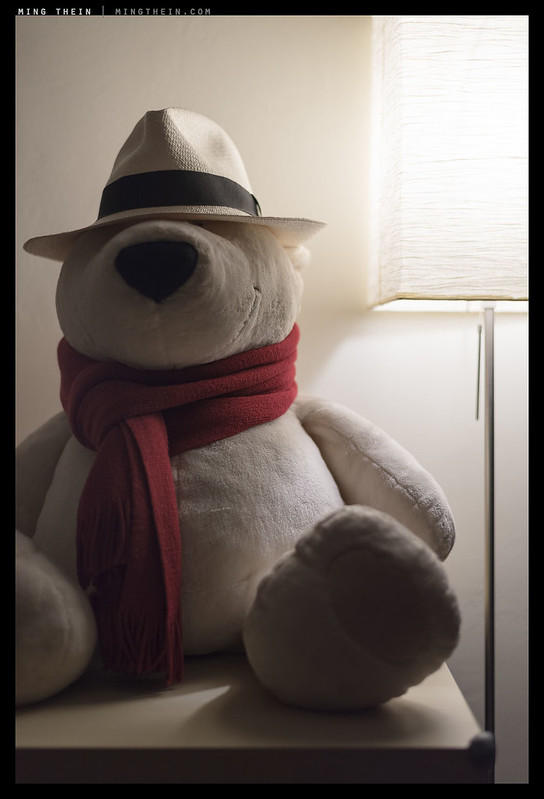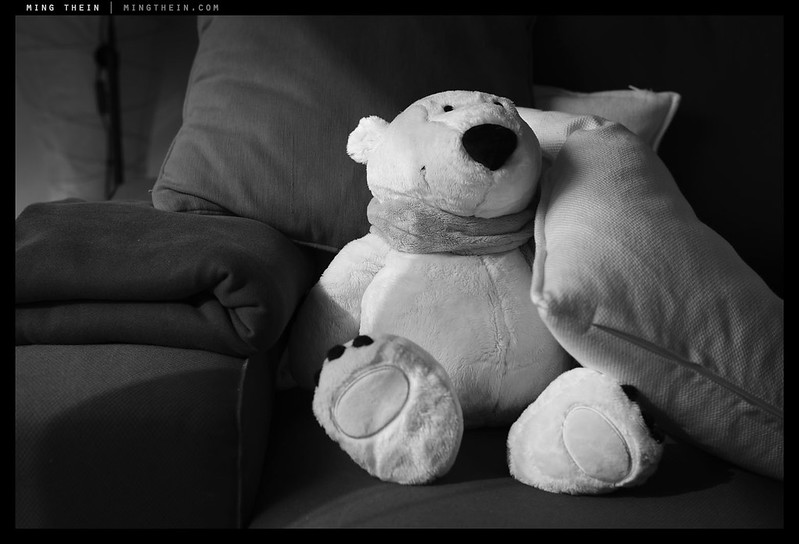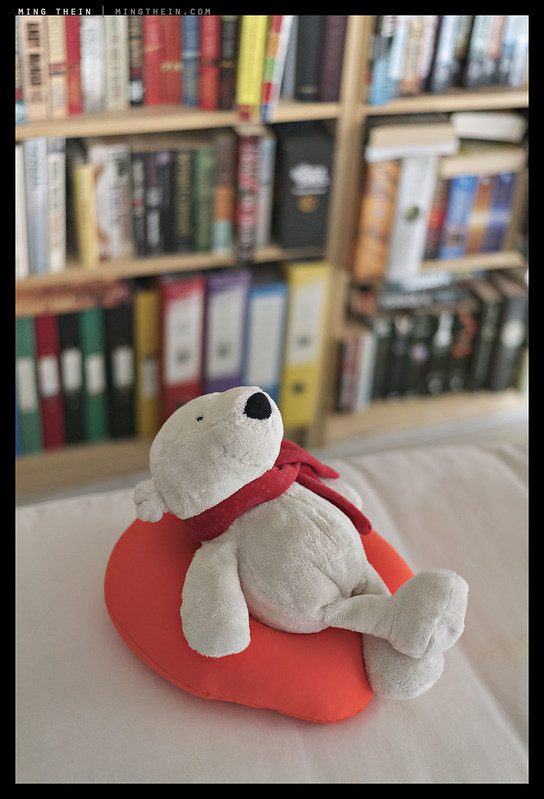
Reference bear #1 wonders what on earth has Ming done now?
I admit to having a change of heart. Yes, I was rather lukewarm bout the initial announcement at Photokina; but I do also remember saying that this would be the camera for a lot of people: right size, right price, right spec. It has “enough” resolution; “enough” performance; and isn’t too large or intimidating. In fact, I’d venture to say that it blows way past sufficiency, but then again, the whole idea of sufficiency is relative anyway. In many ways, this purchase is both rationally driven and a form of recognisance on my part. Bottom line: am I happy? Very much so.
This won’t be a review in the conventional sense; think of it more as a string of logical thoughts with some observations after a couple of days with the camera. I also think there are so many ‘reviewers’ and ‘tests’ out there that frankly, it all gets a bit meaningless – sufficiency is more than met and we’re splitting hairs anyway.
I never intended to buy one. I went to my dealer to trade in some gear I’d not touched in a considerable amount of time, in order to pick up a lens I needed for an upcoming helicopter-based assignment – an 80-400 AFS*. They had D750s, so in my usual curiosity, I asked to handle on. It turns out that was a mistake, because for perhaps the first time in memory for me, Nikon has made The Perfect Grip. All others (horrible DF notwithstanding) – whilst being various degrees of very good to excellent – have still had hot spots that tend to chafe or cramp after several hours of use. The size-to-weight ratio was just right: solid, dense and noticeably smaller than the D810 I brought with me to test the 80-400; I noticed that after about half an hour of shooting the breeze with my dealer, I was still holding on to the D750. Even though it uses some CFRP composites and isn’t all-magnesium, it doesn’t feel plasticky at all; compartments are also sealed but in a rudimentary sort of way. I think it’ll take light rain, but I wouldn’t risk it in weather.
*I reviewed this last year, and came away impressed, but didn’t buy one because I had no need for it at the time. I do now.

Reference bear #2 is merely fluffy and accepting.
I did some quick fiddling and on-the-spot evaluation: AF seemed good; high ISO seemed a bit cleaner than the D810, but there’s only so much you can tell from the back of camera LCD. The tilt screen and enhanced video features tipped me over a bit, because I have some video production work coming up in the next couple of months and early next year; yes, the E-M1s will still be used thanks to their incredible stabilisers, but I really want to be filming with Zeiss/ Otus glass – the 2x crop factor makes getting the right FOVs difficult.
My wallet was a couple of thousand dollars lighter when I left the store.
It hit me much later that the reason why the D750 is so compelling is not because it excels in any one area, but because it has a very strongly matched set of capabilities across the board, and is balanced; the resolution is excellent but not at the expense of high ISO or silly focusing precision requirements; the viewfinder is large enough and the focusing screen good enough that you can manually focus the Otii in a pinch; it will track moving objects in AF-C and 51-point 3D mode as well or better than the D3/D700 cameras, which I used that way all the time – except with 24MP. And it bursts just this side of ‘fast enough’ to use it in quickly changing situations, with the AF able to keep up and track all the while. It is primarily a stills camera, but with sensible enough controls and options for video work including that tilt screen, HDMI out and audio in/out for monitoring, plus very linear/fluid 1080P/60/50/30/25/24 and lesser resolutions. It doesn’t feel big. It also has handy customisable U1 and U2 positions on the mode ideal – I really, really wish my D810 had this. You give up the shortcut cluster on the left shoulder, which puts it into the ‘prosumer body’ category, but honestly, I don’t really care. Utility first.

Reference bear #3 says you shouldn’t mess with the mafia (status quo)
Moreover, it doesn’t feel that serious. This is going to sound like a very odd thing to say, but when paired with a small AF prime, it becomes a fun camera; the kind of thing you take out when you’re not seriously wanting to shoot, but might encounter something worthy of a grab or when you’re with friends/ family and want to do a little social documentary (something which honestly I’ve been neglecting for some time; I really need to restart again). It’s small enough that in this configuration you put it in a bag with other things and don’t notice it’s there; a couple of small primes or a 50mm and a paired compact like the GR covers pretty much everything at high quality and isn’t at all obtrusive. It’s not the same as me carrying a 645Z or D810 and Otus; those are Serious cameras with a capital S – the kind that you only use when you are 100% focused on making images without any compromises.
I realize at this point I might be coming across as a little hypocritical. The problem is that once you’re used to a certain level of pixel quality, then everything else is a little unsatisfying; worst thing is you come across something worthy of shooting properly, rue the fact that you have the gear…but left it at home. A bridge camera, 1″ compact, or crop sensor mirrorless won’t do simply because you have been spoiled by D810 and 645Z-levels of pixel quality. On the other side of the fence is the fact I’d never want to Ultraprint some things like family documentary or certain subjects that just lack detail to begin with; I don’t actually need a D810 or 645Z for that – it’s overkill. And here’s my recognisance of what constitutes sufficiency. No, it’s not a resolution thing; it’s a tonality/dynamic range/rendering style thing.
And the D750 delivers on that front. As far as I can tell, the sensor’s native response and dynamic range are not heavily biased to shadows (like the D800) or highlights (like the D810) but is somewhere balanced in the middle, with good recoverability on either end. I’d say it’s not quite as impressive as either 800-series camera or 645Z for outright dynamic range, but it’s not far off. And what it gives up there, it more than makes up for in high ISO performance – I’d say it’s easily a stop or more cleaner than my D810 at the pixel level, and even downsampling the D810 doesn’t make up for this difference – unlike against the D4 or D4s, which have half the resolution. DPReview’s comparator seems to support my early findings – what’s remarkable is not just that the D750 is cleaner at the pixel level than the D4S, it’s also got better acuity and more pixels, for more overall detail. Short of a 645Z file downsampled to say 15MP, I think we may have a new low light champion – even more so since the D750’s AF ability matches its low noise performance. The files have the kind of ‘push-pull-ability’ that maintain integrity even at higher ISOs that again remind me of the D3/D700; they just seem to take heavy dodging and burning better than the D800E/D810.

Reference bear #4; looks like #2 but isn’t – much like how a D810 and D750 look similar to your spouse. If you like this tonality, I cover black and white conversion methods extensively in The Monochrome Masterclass video.
Yes, there’s still an AA filter over the sensor, but fortunately, it seems to be quite a lot weaker than the one in the D600/610, and images sharpen up nicely. I’d suggest doubling your sharpening amount over a comparable camera with no AA filter. They also have a pleasingly natural tonal richness to them. Black and white conversion potential is similar to the D800E, i.e. good but not outstanding; it’s not as natural as the D810 because the sensor lacks that extreme dynamic range bias towards the highlights.
Interestingly, the AF system seems to be Nikon’s most capable yet; it will happily track a subject across the frame from point to point, and deliver an 80-90% in-focus hit rate – with f1.8 primes wide open in marginal light. My D810 doesn’t quite manage this, probably because of the increased resolution, and possibly because there are some AF hardware differences between the two cameras. Let’s not even talk about the D800E. The last time I saw this kind of AF performance was in my D3 and D700. So it seems there’s yet another rational reason to look at a D750: low light or moving subjects. And yes, I think 6.5fps is just on the right side of ‘enough*’ for documentary work – I use the D800E and D810, and those are already there. Note: all lenses needed a little fine tuning, but for the most part, they’re close to being good out of the box. Nikon has clearly improved its tolerances and QC in recent times; my D810 arrived this way, too.
*It’s not so much about absolute frame rates as shot-to-shot times and responsiveness. I shoot the GR in single frame mode, and most of the time it’s fast enough, too.
I still can’t say I like the viewfinder that much; it’s like the D810’s – okay-big, okay-bright, can be used for MF in a pinch, but really not as good as it should be. It’s made worse by the fact that you can no longer easily adjust the mirror zero position; the new mirror mechanism means these screws inside the mirror box have been relocated somewhere non-accessible. Fortunately, my camera seems pretty close to being bang on – not that I can tell for sure, because we’re still cursed with the standard matte screen.

Reference bear #5: fun and enjoyment are important.
There are a couple of other observations I’d like to finish with before wrapping up: firstly, the mirror/ shutter mechanism is very well damped and low-pitch; both quiet and seemingly quite vibration-free. Much like the D810’s actually. I think the days of ‘sharp’ sounding Nikons are numbered. Secondly, battery life seems to be similar or slightly worse than the D810, but you’re still looking at easily 1000+ frames per charge. Finally, it seems this sensor runs electronic front curtain by default in live view, mirror up and exposure delay modes; I can’t hear the first curtain run, and the whole action sounds much like the D810 in EFC mode. There is a catch, though: 1/4000s maximum speed, and sync speed is 1/200s without FP modes. I see only the maximum speed possibly being an issue if you use this for action, but even then, only rarely. It won’t replace a D810 for ultimate image quality, but then again, you’d be an idiot to buy one thinking that in the first place. They really aren’t so much competitive as complementary.
You may be wondering why I’ve used some very odd images to illustrate this post; it’s because this is the way I view this camera: it’s something a little less serious for the times when I’d regret not having a camera, but I would also regret having a compromise. The fact that it also adds capabilities missing from my current arsenal which I would actually use under certain circumstances (better AF tracking, higher frame rates, higher usable ISOs, tilt screen, better video) is a bonus. It actually puts something back in to photography for me that I was missing at times: the fun factor. I can’t say exactly what it is about it that does this, seeing as the camera is really a synthesis of parts and design and nothing at all groundbreaking.
I could post more comparisons, crops, ISO series, or even images; but you’ve seen enough of those elsewhere to know that the technical details don’t matter very much these days, and I’m pretty confident I can make a strong image with it (much like every other camera of the last five years); it’s down to the photographer anyway. Instead of continuing to give justifications to both the audience and myself as to why it’s a good idea to buy one, the simple answer is that all of these reasons are probably so I feel less guilty about spending money on something I don’t really need; it doesn’t matter. Is it the D700’s true successor? Probably. What does matter is that for now, for some inexplicable reason, I enjoy using this thing – immensely so. And I’m not sure there’s a better recommendation I can give than that. Perhaps it’s like Goldilocks: just right, and highly recommended.
The Nikon D750 is available here from B&H and Amazon. Polar bears of various vintages by Nici.
Coda: some experimentation yields that the D750 uses the same size/thickness focusing screen as the D800/E and D810; however, the little alignment tab is in the wrong place. However, some careful filing can take care of this. I installed a spare split-prism screen, so modified. My surprise of the day was that the mirror on this camera was perfectly aligned – no shimming or movement required, which is a good thing because there is no obvious way to change the mirror alignment – all of the eccentric screws inside the mirror box are gone. Manual focus is now a breeze, as is checking AF. Hopefully this is a sign of tighter QC rather than random luck…perhaps I should buy a lottery ticket anyway, just in case.
__________________
__________________
Limited edition Ultraprints of my work are available from mingthein.gallery
__________________
Visit the Teaching Store to up your photographic game – including workshop and Photoshop Workflow videos and the customized Email School of Photography; or go mobile with the Photography Compendium for iPad. You can also get your gear from B&H and Amazon. Prices are the same as normal, however a small portion of your purchase value is referred back to me. Thanks!
Don’t forget to like us on Facebook and join the reader Flickr group!
Images and content copyright Ming Thein | mingthein.com 2012 onwards. All rights reserved






Hi Ming Thein, I’m using a D750 myself, and am curious to hear your feedback about the split prism focusing screen. May I know where did you acquire one, and how reliable is it? I’ve a 50mm f1.2 AIS that’s criminally underused on my Nikon that I really ought to use a lot more if manual focusing on the D750 wasn’t such a drag (though it’s my to-go portrait lens on my APS-C mirrorless systems).
I had to modify a D810 fit screen and reshim both the screen and adjust mirror alignment. Not easy, and not recommended for beginners. The company that makes the focusing screens was frankly not very pleasant to deal with, either.
Ah, thank you for your input. I was hoping it would be as simple as replacing a focusing screen on a film SLR. The D750 is my workhorse, and as much as I’d like to mount a split prism screen on it, I wouldn’t want to subject it through the kind of modifications you did and possibly wreck my camera.
It is, but the results of misalignment are far more obvious on digital as the sensor plane is rather more two dimensional and of higher resolving power than the (3D) thickness of film emulsion…
Ah, I see what you mean. I’d have to find someone in KL with the knowhow I guess. Probably best to start with someone who knows his way around film cameras. Thanks again for your time!
That’s a shame, I love that lens 🙂 end up using live view under f/2 most of the time. I’d say I use mine about 80% of the time.
No point in shooting it stopped down; you might as well get something smaller/lighter/AF.
Yeah, I meant for the 50mm f1.2 AIS to be used wide open most of the time. It’s fantastic when adapted over to a mirrorless, but I using it on a cropped sensor is kinda cheating the lens of its true potential (though it is a gorgeous portrait lens). It does yield amazing results on the D750 when I’m able to work with it, but it’s a clunky experience at best to manual focus using the indicator arrows in the OVF, and worse still in live view.. Hence why I’d like to get a split prism focusing screen for it Installing the screen isn’t tough, but making sure it’s properly calibrated to the mirror is a different question altogether.
Why not use it with a speed booster and you’ll have a, what?, 32 mm f/0,77 AiS for your MFT camera? Or is it Sony?
Yeah, I hadn’t thought of that, as the 75mm equivalent on my Sony a6000 made it really useful for portraits. What’s your recommendation for a good and reasonably priced manual speed booster?
Over the last few months I’ve been reading quite a few comments from reputable photo websites regarding the D750 having the same sensor as the D610. And this is not stated as a bad thing! I know the D750 is the better camera, more refined, updated features, improvements, etc. I’m considering one of these cameras later this year. Prices are coming down on both. I’m leaning toward the D750, but for those who are focusing on IQ alone, and can do without the nicer features of the D750, the D610 seems like quite a bargain. This fall there should be some interesting deals on both.
I think the D750 just dropped in price already in the US, no?
Hi Ming,
I was able to test out a D750 today as I am still having AF issues with my DF. It may have been luck as I didnt have much time, but the pictures I took with the 35mm 1.8g on the D750 seemed much sharper than those from my DF. At 100% I didnt expect to see so much of a difference. Is this your experience? Also, my main concern with the D750 is the flip out screens durability. I would enjoy using it, but Im pretty clumsy with flimsy objects and am scared to break it. I wouldnt be able to afford the repair here in scandinavia!
Thanks,
Daniel
Can’t say as I never used the DF. That was the most uncomfortable camera I’ve ever handled.
The D750 may well be sharper at the pixel level as it uses a weaker AA filter than the DF. I’ve not had issues with the flip out screen, which I used pretty often.
Can you please comment on the kit lens 24-120 that comes with D750!!
Please read my review.
Hi Ming
Would you recommend the D750 as a first full-frame camera? Currently I have a Sony A6000 and few lenses but want to move to full-frame. I mainly shoot on trips & vacations. Two things I want are better low light autofocus and better high-ISO capabilities.
Thanks
Yes. You’ll get both with the D750. I think it’s better bang for buck than the D4/5, too.
You don’t even mention the D610. Maybe it’s not worth it?
Big difference in haptics, ergonomics and AF system to the D750. The price difference here isn’t that great, either.
For an all purpose camera (and a system with a future); D750 or A7rii?
I’d still go with the D750. Having shot with both, I feel the D750 has a higher overall hit rate and wider envelope.
“easily 1000+ frames per charge.”?? What format are we talking over here? Thanks
I only shoot RAW.
A long time I wondered what to choose D750 or D610. I decided, however, on D610, in my opinion, although the difference is minimal. Very well you have described D750.